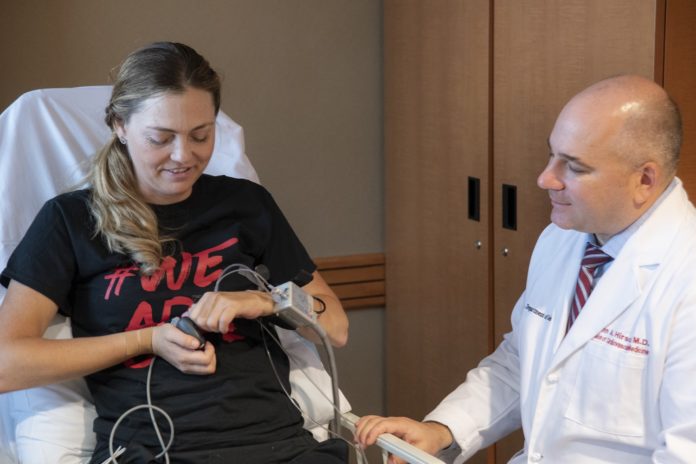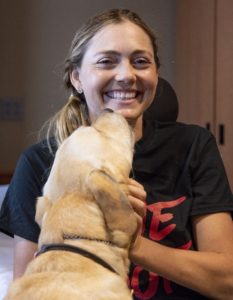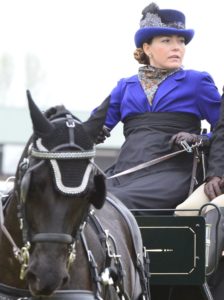
For the first time since 2009, Stefanie Putnam is able to prepare – and eat – meals for herself, put the vest on her service dog, Kaz, and drive herself to activities with her horse without losing consciousness or gasping for breath.
“My whole life has opened up for me again!” Putnam said.
A C4 spinal cord injury in 2009 left Putnam paralyzed from the neck down and suffering from chronic low blood pressure. She relied on medication and tight corsets to maintain her blood pressure, but she still passed out five or six times a day.
Her new lease on life is the result of spinal cord epidural stimulation (scES) she received as a participant in research at the University of Louisville’s Kentucky Spinal Cord injury Research Center (KSCIRC) to aid recovery for individuals with spinal cord injury. Research published today in JAMA Neurology describes the improvements Putnam and three other research participants experienced in blood pressure and heart rate regulation during and after scES. All four participants had chronic, complete cervical spinal cord injury, persistent low resting blood pressure and blood pressure decrease when sitting up prior to receiving scES.
“From a quality of life perspective, orthostatic hypotension, or low blood pressure when sitting up, is truly life limiting,” said Glenn A. Hirsch, MD, a cardiologist with the UofL School of Medicine and co-author of the study.
Spinal cord epidural stimulation uses an implanted electrode array to deliver electrical signals to the lumbar spine. For this study, research participants received stimulation using specific configurations selected to target cardiovascular function, monitoring blood pressure and cardiovascular function throughout, for an average of 89 daily, two-hour sessions. Earlier research showed the benefits of scES in controlling cardiovascular function during stimulation, but this data reveals participants’ blood pressure and heart rate remained stabilized between sessions, showing an enduring effect.
“What was most surprising was that only having it on for a few hours a day, we were noticing participants having normal blood pressure through longer periods of each day,” Hirsch said. “We are noticing it now across the research participants who had that problem, that there is a prolonged stabilizing effect even after the stimulator is turned off.”

Since receiving scES for her cardiovascular symptoms, Putnam said she enjoys increased independence and alertness, and she no longer needs medication to increase her blood pressure.
“I am an active member in my own life instead of merely existing. I am really living! I can prepare and cook my own meals. I can feed myself and carry on a conversation. Without the disruption of passing out or gasping for breaths in the middle of a task or having to stop and be back in my chair for two hours at a time, I can accomplish so much more. Now I can live my best life with energy to focus on my future.” Putnam said.
Research at UofL using scES, led by Susan Harkema, PhD, associate director of KSCIRC and professor of neurosurgery at UofL, began with the goal of restoring motor function. However, researchers and participants soon noticed stimulation led to improvements in cardiovascular and autonomic systems as well.
“In our motor system studies, we observed that we could actually regulate blood pressure without activating the motor system. That launched us into another area of research,” Harkema said. “Many people don’t realize that walking in many cases is not really the aspect that makes their daily lives most difficult because they have cardiovascular dysfunction and problems with respiratory, bowel, bladder, and sexual function. All of those things are disrupted so every day is incredibly difficult for people with spinal cord injury.”

In ongoing research to explore further the life-enhancing effects of epidural stimulation, the UofL researchers are conducting a six-year study with 36 participants with chronic, complete spinal cord injuries.
Today’s published research, “Epidural Spinal Cord Stimulation Training and Sustained Recovery of Cardiovascular Function in Individuals with Chronic Cervical Spinal Cord Injury,” was supported by the Craig H. Neilsen Foundation, The Leona M. and Harry B. Helmsley Charitable Trust, University of Louisville Hospital, Christopher & Dana Reeve Foundation and Medtronic Plc.
Check out Stefanie’s story in her own words here:





























